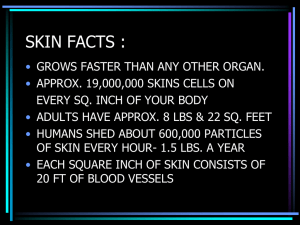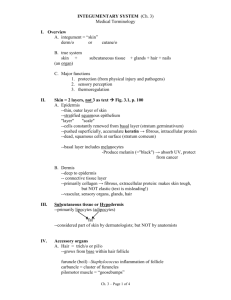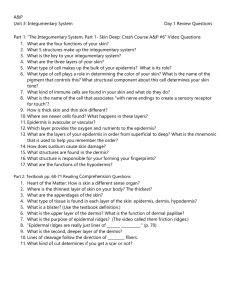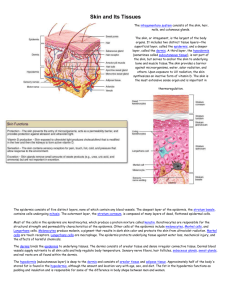Automated Segmentation and Analysis of the Epidermis Area in Skin
advertisement
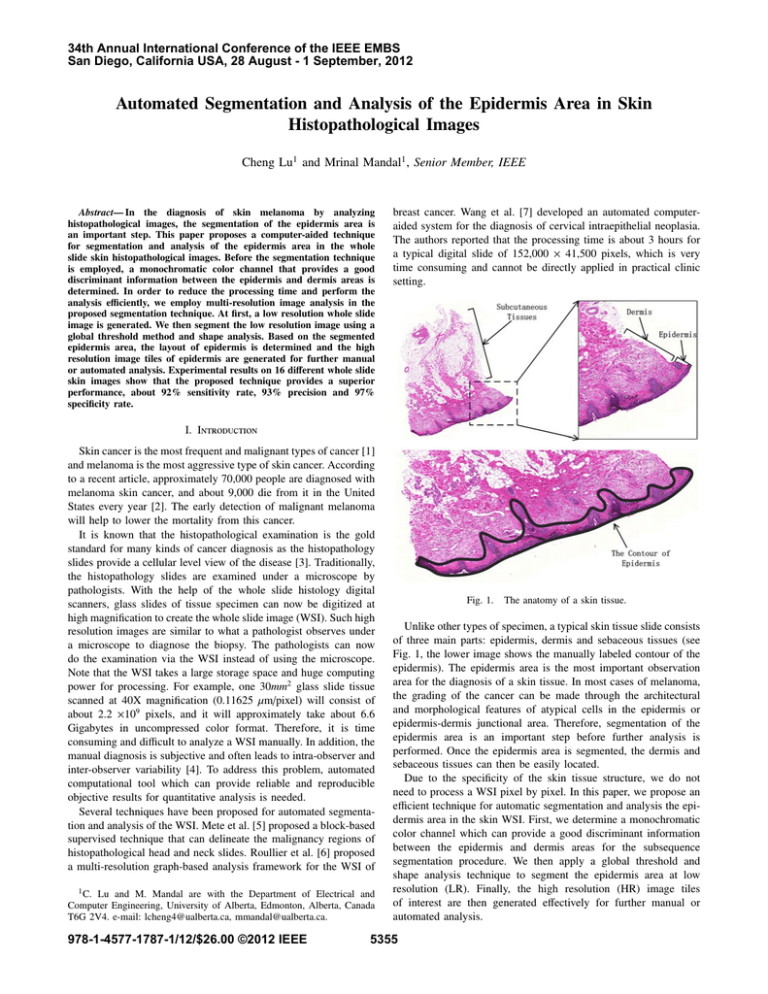
34th Annual International Conference of the IEEE EMBS
San Diego, California USA, 28 August - 1 September, 2012
Automated Segmentation and Analysis of the Epidermis Area in Skin
Histopathological Images
Cheng Lu1 and Mrinal Mandal1 , Senior Member, IEEE
Abstract— In the diagnosis of skin melanoma by analyzing
histopathological images, the segmentation of the epidermis area is
an important step. This paper proposes a computer-aided technique
for segmentation and analysis of the epidermis area in the whole
slide skin histopathological images. Before the segmentation technique
is employed, a monochromatic color channel that provides a good
discriminant information between the epidermis and dermis areas is
determined. In order to reduce the processing time and perform the
analysis efficiently, we employ multi-resolution image analysis in the
proposed segmentation technique. At first, a low resolution whole slide
image is generated. We then segment the low resolution image using a
global threshold method and shape analysis. Based on the segmented
epidermis area, the layout of epidermis is determined and the high
resolution image tiles of epidermis are generated for further manual
or automated analysis. Experimental results on 16 different whole slide
skin images show that the proposed technique provides a superior
performance, about 92% sensitivity rate, 93% precision and 97%
specificity rate.
breast cancer. Wang et al. [7] developed an automated computeraided system for the diagnosis of cervical intraepithelial neoplasia.
The authors reported that the processing time is about 3 hours for
a typical digital slide of 152,000 × 41,500 pixels, which is very
time consuming and cannot be directly applied in practical clinic
setting.
I. I
Skin cancer is the most frequent and malignant types of cancer [1]
and melanoma is the most aggressive type of skin cancer. According
to a recent article, approximately 70,000 people are diagnosed with
melanoma skin cancer, and about 9,000 die from it in the United
States every year [2]. The early detection of malignant melanoma
will help to lower the mortality from this cancer.
It is known that the histopathological examination is the gold
standard for many kinds of cancer diagnosis as the histopathology
slides provide a cellular level view of the disease [3]. Traditionally,
the histopathology slides are examined under a microscope by
pathologists. With the help of the whole slide histology digital
scanners, glass slides of tissue specimen can now be digitized at
high magnification to create the whole slide image (WSI). Such high
resolution images are similar to what a pathologist observes under
a microscope to diagnose the biopsy. The pathologists can now
do the examination via the WSI instead of using the microscope.
Note that the WSI takes a large storage space and huge computing
power for processing. For example, one 30mm2 glass slide tissue
scanned at 40X magnification (0.11625 µm/pixel) will consist of
about 2.2 ×109 pixels, and it will approximately take about 6.6
Gigabytes in uncompressed color format. Therefore, it is time
consuming and difficult to analyze a WSI manually. In addition, the
manual diagnosis is subjective and often leads to intra-observer and
inter-observer variability [4]. To address this problem, automated
computational tool which can provide reliable and reproducible
objective results for quantitative analysis is needed.
Several techniques have been proposed for automated segmentation and analysis of the WSI. Mete et al. [5] proposed a block-based
supervised technique that can delineate the malignancy regions of
histopathological head and neck slides. Roullier et al. [6] proposed
a multi-resolution graph-based analysis framework for the WSI of
1 C. Lu and M. Mandal are with the Department of Electrical and
Computer Engineering, University of Alberta, Edmonton, Alberta, Canada
T6G 2V4. e-mail: lcheng4@ualberta.ca, mmandal@ualberta.ca.
978-1-4577-1787-1/12/$26.00 ©2012 IEEE
Fig. 1.
The anatomy of a skin tissue.
Unlike other types of specimen, a typical skin tissue slide consists
of three main parts: epidermis, dermis and sebaceous tissues (see
Fig. 1, the lower image shows the manually labeled contour of the
epidermis). The epidermis area is the most important observation
area for the diagnosis of a skin tissue. In most cases of melanoma,
the grading of the cancer can be made through the architectural
and morphological features of atypical cells in the epidermis or
epidermis-dermis junctional area. Therefore, segmentation of the
epidermis area is an important step before further analysis is
performed. Once the epidermis area is segmented, the dermis and
sebaceous tissues can then be easily located.
Due to the specificity of the skin tissue structure, we do not
need to process a WSI pixel by pixel. In this paper, we propose an
efficient technique for automatic segmentation and analysis the epidermis area in the skin WSI. First, we determine a monochromatic
color channel which can provide a good discriminant information
between the epidermis and dermis areas for the subsequence
segmentation procedure. We then apply a global threshold and
shape analysis technique to segment the epidermis area at low
resolution (LR). Finally, the high resolution (HR) image tiles
of interest are then generated effectively for further manual or
automated analysis.
5355
II. S M C C
In the skin tissue, the epidermis area and the dermis area
are closely connected with each other (see Fig. 1). In order to
segment the epidermis area accurately, we need to first determine
a monochrome channel which can provide good distinguishable
information between the epidermis and dermis areas. Note that a
WSI contains {R, G, B} three channels. To obtain a monochrome
channel M, a linear transform A = [a1 , a2 , a3 ] is required, i.e.,
M
=
a1 R + a2 G + a3 B = [R, G, B][a1 , a2 , a3 ]T ,
(1)
s.t., a1 + a2 + a3 = 1.
Denote an image pixel by p and its gray value by g(p). Denote the
pixels belonging to epidermis area as class 1 (denoted as Ω1 ) and the
pixels belonging to the dermis area as class 2 (denoted as Ω2 ). Let
the mean intensity of the epidermis area, dermis area and dermis
+ epidermis areas be denoted as µ1 , µ2 , and µo respectively. In
this work, to distinguish the different classes, we use the following
metric [8]:
σ2
RII = 2inter
(2)
σintra
using transform Agray = [0.299, 0.587, 0.114], and H, S, V channels
from the HSV color model [9] for the 8 test WSIs. It is noted that
the R channel achieve the largest quality metric RII compared to
the other channels. The V channel from the HSV color model also
provides good discriminating information.
Fig. 2 provides a visual evaluation example, where the RGB
color image with R, G, B, gray, H, S, V channels of the WSI1
skin histopathological image are shown. It is observed that in the
red channel and V channel image (shown in Fig. 2(b) and (j),
respectively), the epidermis area is easily distinguishable from its
neighboring dermis area. The corresponding quantitative results are
shown in Table II.
where
σ2intra
σ2inter = w1 (µ1 − µo )2 + w2 (µ2 − µo )2
w1 X
w2 X
=
(g(p) − µ1 )2 +
(g(p) − µ2 )2
N1 p∈Ω
N2 p∈Ω
1
(3)
(4)
2
where w1 and w2 are the size proportion of two classes, i.e., epidermis and dermis, respectively. N1 and N2 are the total number of
pixels in two classes, respectively. The σ2inter and σ2intra are the inter
classes and intra class variances of the pixel intensities. In this work,
we assume that the monochrome channel with a maximum quality
metric RII provides the best discriminant information between the
epidermis and dermis area. In particular, we need to find an optimal
linear transform A∗ which can maximize the quality metric RII , i.e.,
A∗ = maxA∈ΩA (RII ), where ΩA is the space of linear transform A.
In this paper, we use a grid search method to find an approximate
optimal linear transform à which is described as follows.
•
•
•
•
First, we manually label the epidermis and dermis areas for 8
different skin WSIs as the test data set.
A set of 1-by-3 vectors which can approximately cover the
space of the linear transform A, denoted as Ω̃A , is initialized.
The grid step for each variable, i.e., a1 , a2 , and a3 , in the linear
transform is 0.05.
For each possible linear transform A ∈ Ω̃A , the quality metric
RII is calculated.
The linear transform A that corresponds to the maximum
quality metric RII is recorded as the approximate optimal linear
transform Ã.
Fig. 2. An example of the WSI. (a) Original H&E stained color image.
(b), (c), and (d) shows the R, G, and B channel of the image, respectively.
(e) shows the gray channel image. (f), (i), (j) shows the H, S, V channels.
III. S E A
In order to reduce the processing time and efficiently perform the
analysis, we apply multi-resolution image analysis. The schematic
of the proposed technique is shown in Fig. 3. It is observed that
there are four modules in the proposed technique. Module one
generates a LR WSI using down sampling method. Module two
segment the LR image using a global threshold and shape analysis.
In the last two modules, the layout of epidermis is determined, and
the HR image tiles of epidermis are generated for further analysis.
The details of these modules are discussed below.
All the approximate optimal linear transforms à for the 8 test WSIs
with corresponding quality metric RII are presented in Table I. The
8 WSIs are labeled as WSI1, WSI2, · · · ,WSI8, respectively.
It is observed that the coefficient associated with the red channel,
i.e., a1 , is 1 or close to 1 for all the test WSIs. In other words, the red
channel of the RGB color image can provide good distinguishable
information between the epidermis and dermis area. Based on
such observation, in this work, we choose the red channel as the
monochrome channel for latter processing since it is ready to be
used without further calculation, even though it may not be always
the optimal one. This is further validated with results shown in
Table II and Fig. 2. Table II shows the quality metric RII of the R,
G, B channels from RGB color model, the gray channel computed
5356
Fig. 3.
The schematic for the WSI segmentation.
TABLE I
T Ã RII 8 WSI.
Ã
RII
WSI1
[1, 0, 0]
0.36
WSI2
[1, 0, 0]
0.53
WSI3
[0.9, 0.1, 0]
0.37
WSI4
[0.95, 0.05, 0]
0.53
WSI5
[0.85, 0.15, 0]
0.53
WSI6
[1, 0, 0]
0.45
WSI7
[0.9, 0.1, 0]
0.25
WSI8
[0.95, 0.05, 0]
0.24
TABLE II
T RII R, G, B, G, H, S, V 8 WSI.
R
G
B
Gray
H
S
V
WSI1
0.36
0.06
0.10
0.11
0.03
0.07
0.35
WSI2
0.53
0.11
0.21
0.20
0.03
0.11
0.50
WSI3
0.34
0.25
0.10
0.33
0.07
0.26
0.29
WSI4
0.51
0.14
0.27
0.32
0.22
0.19
0.49
WSI5
0.49
0.21
0.20
0.33
0.05
0.24
0.49
WSI6
0.45
0.22
0.21
0.34
0.05
0.23
0.41
WSI7
0.22
0.04
0.03
0.09
0.05
0.07
0.19
WSI8
0.23
0.03
0.01
0.07
0.04
0.05
0.21
A. Image Down-sampling
Given a high resolution WSI Ih as the input image with size r ×c,
we employ down-sampling [10] to create a low resolution image
Il with size (r/k) × (c/k), where k is a down sampling factor. (In
order to reduce the aliasing, a low pass filter is usually applied to
the image before the down sampling.) In this work we have used
k=32, which can reduce a 2.2 × 109 pixel image to a 2.15 × 106
pixels LR image.
B. Segmentation of the Epidermis using Global Threshold and
Shape Analysis
As explained in Section II, the red channel is chosen for the
segmentation. It is observed in Fig. 2(b) that the epidermis area
has darker intensity value compared to the remaining part of a
WSI (see Fig 3). Therefore, we can use a simple thresholding
method combined with the shape analysis to segment the epidermis
area. The thresholding method groups the pixels into two classes:
foreground and background, based on the pixel values. Specifically,
let τ be a selected threshold for the segmentation. The classification
of pixel p with gray value g(p) is then done as follows:
(
f oreground, i f g(p) ≤ τ
p=
(5)
background, i f g(p) > τ
In our problem, the foreground corresponds to the epidermis area.
We apply Otsu’s thresholding [11] method to determine the optimal
threshold for segmentation.
Before the thresholding, the white background (e.g., the pixels
with gray value greater than 240) are removed in order to estimate
more accurate result. Three examples of the threshold results on
different skin tissues are shown in Fig. 4(b), (e), and (h). Note that
the epidermis areas are segmented as well as other low intensity
components, such as hair follicles, blood vessels and other unrelated
tissues. We label all the regions in the binary image via 8-connected
criterion [9] and denote all the 8-connected regions as {Ci }i=1...n ,
where n is the total number of the regions. In a typical image, we
may result in several hundreds candidate regions. A further test is
required to eliminate the unrelated false regions.
In order to eliminate the false regions, we use two criteria: area
and the shape. We first assume that the epidermis area is greater
than a predefined threshold T area . We set T area = N × 0.5%, where
N is the total pixel number of the skin tissue, and the fraction
0.5%, determined based on the domain prior and experiment results,
represents the portion of the epidermis area in the WSI. Secondly,
Fig. 4. Three examples of epidermis segmentation. (a), (d), and (g) are
the original red channel image; (b), (e), and (h) show the results after
thresholding; (c), (f), and (i) show the final binary mask for epidermis.
from the observation, the epidermis area is generally a long and
narrow region. This shape feature can be captured by the major axis
length (l1 ) to minor axis length (l2 ) ratio of a best fit ellipse [12].
Given a 8-connected region Ci , we use the above mentioned
two criteria based on the domain knowledge to determine if it is
epidermis or other tissue components.
(
Ci =
epidermis,
others,
i f A(Ci ) ≥ T area and l1 /l2 ≥ T l
otherwise
(6)
where A(·) is the area operator, A(Ci ) represents the area of region
Ci . Threshold T l is set to 4 empirically to make sure that the
epidermis is long and narrow.
5357
Finally, the holes inside the region are filled to generate the
mask for the epidermis. Three examples of the binary masks for
the epidermis are shown in Fig. 4(c), (f), and (i). Note that the
undesirable regions are removed.
C. Determine the Layout of Epidermis and Generate Image Tiles
The epidermis mask is now available for further processing. In
this section, we divide the epidermis region into several image tiles.
These image tiles will be used for further analysis at high resolution.
The reason behind dividing the epidermis is two-fold:
• Accuracy analysis. The binary mask of the epidermis is obtained from the low resolution image Il based on the global
threshold and shape analysis as the local intensity variants may
incur inaccuracy segmentation results (usually under segmentation). By analyzing the epidermis mask locally, it is expected
that we can achieve better segmentation and analysis results.
• Efficient computation. Normally, the epidermis area which
taking about 1% to 10% of the whole image. That means about
22 - 220 Mega pixels need to be manipulated for a 30mm2
tissue, which will take a considerable amount of computational
resources. By dividing the rough epidermis mask into image
tiles, we can use the parallel computation technique [13] to
distribute the processing load into each node which will greatly
help to do the computation in an efficient way.
First, we need to divide the whole image into non-overlapping
image blocks. A grid Gl which indicates the non-overlap blocks
are defined. The grid has the same size as that of the LR image Il ,
and the width and height of the block are denoted as bw and bh ,
respectively. We set bw = 2000/k and bh = 1000/k, remind that k
is the down sampling factor for the high resolution image Ih . This
grid is overlapped onto the binary image as shown in Fig. 5(a).
Note that we are only interest in the image blocks which contain
the epidermis mask.
Fig. 6. An illustration of the horizontal image tile and vertical image tile.
(a) shows the lower portion of Fig. 5(a). Note the blue rectangle that points
to (c) represents an image tile obtained horizontally whereas the yellow
rectangle that points to (c) represents an image tile obtained vertically. The
image tile is consisted of several image blocks.
the epidermis in this example is lying horizontally, it is easy to
note that generation of the image tile vertically provides intact
information rather than generation of the image tile horizontally.
Based on the discussion above, in this work, we propose to
generate reasonable image tiles for further analysis. In order to do
that, the layout of the epidermis mask should be first determined.
Generally, the skin tissues on the glass slides have two different
layouts: horizontal or vertical. In order to determine the layout, we
calculate a matrix L as follows:
1,
L(u, v) =
0,
P h
Pvbw
i f ub
B(i, j) ≥ T b
h +1 P j=(v−1)bw +1
Pi=(u−1)b
vbw
h
i f ub
i=(u−1)bh +1
j=(v−1)bw +1 B(i, j) < T b
(7)
where B is the binary image. u, v and i, j are indices for the 2-D
matrix L and binary image B, respectively. Threshold T b = 0.1 ×
bw × bh considers the noise effect. After calculating the matrix L,
we use first order polynomial fitting to determine the fitted line.
This is shown in Fig. 5(b), where the white blocks correspond to
the value 1 in L while black blocks correspond to the value 0. The
solid line across the white blocks is the fitted line based on the
coordinates of the value 1 in L. The layout of the epidermis can
now be determined by the acute angle θ between the fitted line and
Fig. 5. An example for determining the layout of the epidermis. (a) shows
the grid on to the binary image; (b) shows the blocks which contains the
rough epidermis area (white blocks) as well as the fitted line (red solid line)
based on the coordinates of the value 1 in L; (c) illustrates the acute angle
θ between the fitted line and the referenced horizontal line.
In the manual examination of the epidermis, a pathologist usually
takes into consider the tissue structure and cytological features
vertically across the epidermis. In the computerized image analysis,
it is also reasonable to analyze the cytological components vertically
across the epidermis. The idea is shown in Fig. 6. A horizontal
image tile that consists of several blocks is shown in Fig. 6(b).
In contrast, Fig. 6(c) shows an image tile consisting of several
blocks generated vertically. It is clear that the image tile obtained
vertically in this example preserves all the sub-layer information
of the epidermis very well. On the other hand, it is difficult to
analyze the image tile shown in Fig. 6(b) since it provides only
partial information from different location of the epidermis. Since
Fig. 7. An example of generating the reasonable image tiles. Note the
layout of the epidermis is horizontal in this example, so the image tiles are
generated vertically. The rectangles indicate the generated image tiles for
further processing. Some of the snapshot of the image tiles are present.
5358
the referenced horizontal line which defined as follows:
(
horizontal, i f 0◦ ≤ θ ≤ 45◦
Layout =
vertical,
i f 45◦ < θ ≤ 90◦
(8)
The idea for determining the layout based on the angle θ is
illustrated in Fig. 5(c), where the dash line represents the referenced
horizontal line.
Based on the layout of the epidermis, we can now generate the
image tiles for further analysis. If the layout is vertical, we generate
the image tiles by stitching the image blocks with epidermis
mask horizontally. On the other hand, if the layout is horizontal,
we generate the image tiles by stitching the image blocks with
epidermis mask vertically. An example is illustrated in Fig. 7. Note
that the grid Gl for the LR image should be mapped to the HR
image domain in order to generate the HR image tiles.
IV. E E S
We have evaluated the proposed technique on 16 different skin
WSIs. These images are captured from different skin tissue samples
which contain normal, nevus, and melanoma. These images are
captured under 40X magnification on Carl Zeiss MIRAX MIDI
Scanning system.
In the evaluation, the manually labeled epidermis areas (pixellevel contour of the epidermis) are treated as the ground truths. We
define GT as the ground truth region of the epidermis, S EG as the
segmented region obtained by the proposed technique. Three evaluation metrics: sensitivity (SEN), specificity (SPE), precision (PRE)
are defined as follows:
T
|GT S EG|
× 100%
(9)
S EN =
|GT |
T
|GT S EG|
PRE =
× 100%
(10)
|S EG|
T
|GT S EG|
S PE =
× 100%
(11)
|GT |
where | · | is the cardinality operator. We also use another evaluation
metric: mean absolute distance (MAD) which is defined as follows:
MAD(C GT , C S EG ) =
M
1 X
[min||CiGT − C Sj EG ||]
M i=1
(12)
where C GT and C S EG are the contour of the ground truth region
and segmented region, respectively. CiGT and C Sj EG represent the ith
pixel and the jth pixel on the contour of the ground truth region
and segmented region, respectively. M is the total number of pixels
on the contour of the ground truth region.
TABLE III
P .
Red channel
V channel
Gray channel
PRE
93.51%
94.06%
4.51%
SPE
96.95%
96.97%
89.13%
SEN
92.13%
86.82%
36.98%
MAD
1.78
3.61
4528
The performance of the epidermis segmentation technique on
the red channel, V channel, and Gray channel images for 16 test
WSIs are shown in Table III. It is observed that the proposed
technique provides a good performance on both red channel and V
channel images since these two channels provide good discriminant
information as discussed in Section II. The proposed segmentation
technique if applied on the gray channel image generates a poor
performance because in the gray channel image the epidermis and
dermis areas are hard to differentiate by using a threshold. It noted
that other monochromatic color channels (discussed in Section II)
also have poor performance (the results are not shown here).
The average processing time for segment the epidermis area for
an image with 2800 × 3200 pixels is about 2.38 seconds.
V. C
In this work, in order to perform an effective segmentation, a
monochromatic color channel is first determined. By using the
pre-determined monochromatic channel, a hybrid technique based
on global threshold and shape analysis is employed to segment
the epidermis from the WSI. We also discuss how to generate
the HR image tiles of the epidermis for further analysis. Experimental results show that the proposed technique provides a good
performance. The proposed technique is an important pre-requisite
procedure towards the automated skin histopathological image
analysis since the epidermis area is the key area to be examined.
In addition, the morphological features, e.g., depth and symmetry,
are useful factors in the skin cancer diagnosis procedure. In the
future, further quantitative analysis, e.g., melanocytes detection in
the epidermis, will be carried out based on this work.
ACKNOWLEDGMENT
We thank Dr. Naresh Jha, and Dr. Muhammad Mahmood of the
University of Alberta Hospital for providing the images and giving
helpful advice.
R
[1] I. Maglogiannis and C. Doukas, “Overview of advanced computer
vision systems for skin lesions characterization,” IEEE Transactions on
Information Technology in Biomedicine, vol. 13, no. 5, pp. 721–733,
2009.
[2] A. C. Society, “What are the key statistics about melanoma?” American Cancer Society, Tech. Rep., 2008.
[3] V. Kumar, A. Abbas, N. Fausto, et al., Robbins and Cotran pathologic
basis of disease. Elsevier Saunders Philadelphia:, 2005.
[4] S. Ismail, A. Colclough, J. Dinnen, D. Eakins, D. Evans, E. Gradwell,
J. O’Sullivan, J. Summerell, and R. Newcombe, “Observer variation
in histopathological diagnosis and grading of cervical intraepithelial
neoplasia.” British Medical Journal, vol. 298, no. 6675, p. 707, 1989.
[5] M. Mete, X. Xu, C.-Y. Fan, and G. Shafirstein, “Automatic delineation
of malignancy in histopathological head and neck slides.” BMC
Bioinformatics, vol. 8 Suppl 7, p. S17, 2007. [Online]. Available:
http://dx.doi.org/10.1186/1471-2105-8-S7-S17
[6] V. Roullier, L. O., T. V.T., and E. A., “Multi-resolution graphbased analysis of histopathological whole slide images: Application to
mitotic cell extraction and visualization,” Computer medical imaging
and graph, 2011.
[7] Y. Wang, D. Crookes, O. S. Eldin, S. Wang, P. Hamilton, and
J. Diamond, “Assisted diagnosis of cervical intraepithelial neoplasia
(cin),” IEEE Journal of Selected Topics in Signal Processing, vol. 3,
no. 1, pp. 112–121, 2009.
[8] R. Duda, P. Hart, and D. Stork, Pattern classification. Citeseer, 2001,
vol. 2.
[9] R. Gonzalez and R. Woods, Digital image processing, 2002.
[10] P. Burt and E. Adelson, “The laplacian pyramid as a compact image
code,” IEEE Transactions on Communications, vol. 31, no. 4, pp. 532–
540, 1983.
[11] N. Otsu, “A threshold selection method from gray-level histograms,”
IEEE Transactions on Systems, Man, and Cybernetics, vol. 9, no. 1,
pp. 62–66, 1979.
[12] M. Fitzgibbon, A. W.and Pilu and R. B. Fisher, “Direct least-squares
fitting of ellipses,” IEEE Transactions on Pattern Analysis and Machine Intelligence, vol. 21, no. 5, pp. 476–480, May 1999.
[13] B. Cambazoglu, O. Sertel, J. Kong, J. Saltz, M. Gurcan, and
U. Catalyurek, “Efficient processing of pathological images using the
grid: computer-aided prognosis of neuroblastoma,” in Proceedings
of the 5th IEEE workshop on Challenges of large applications in
distributed environments. ACM, 2007, pp. 35–41.
5359

